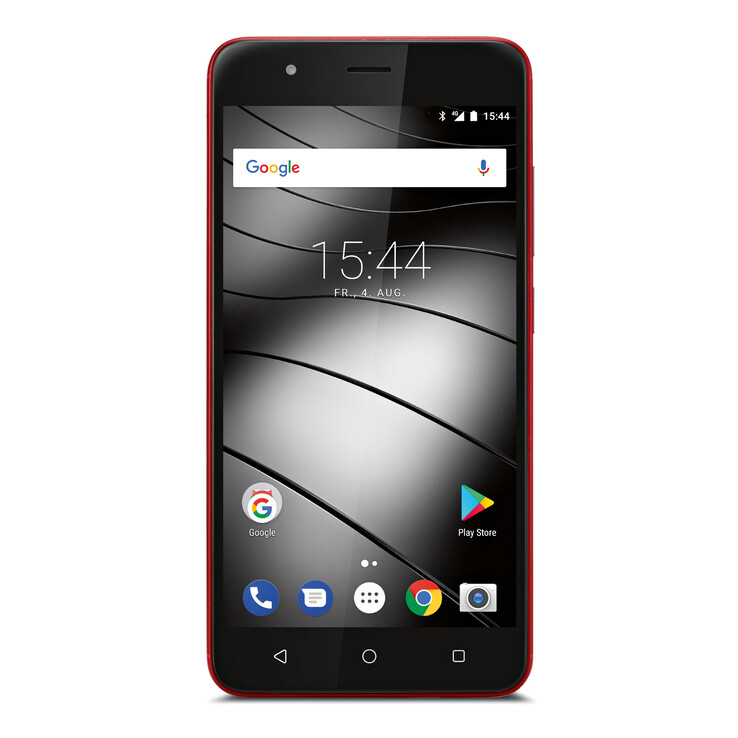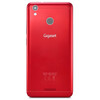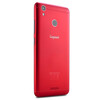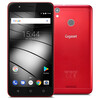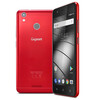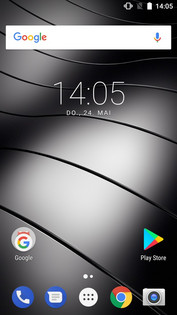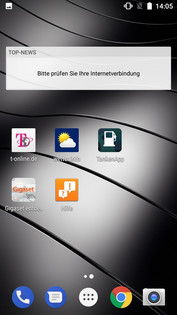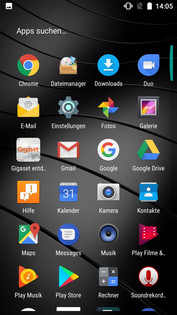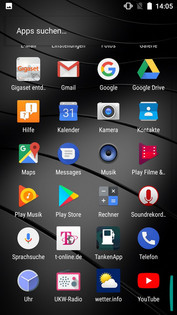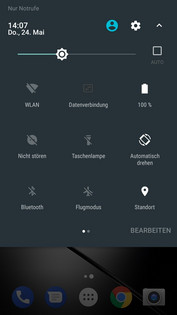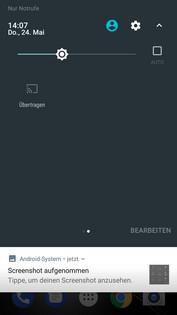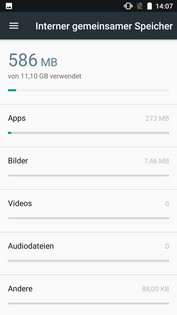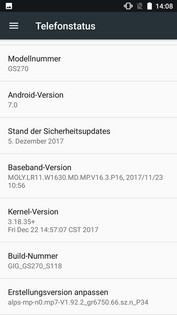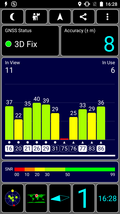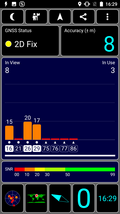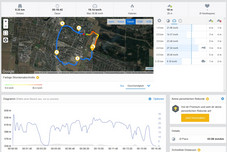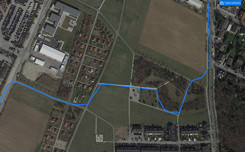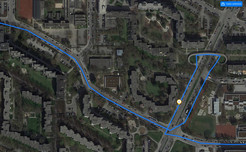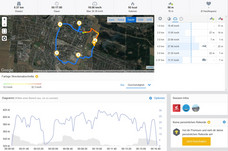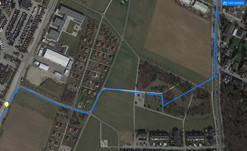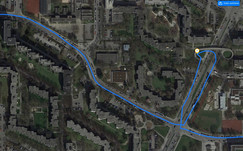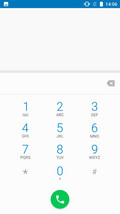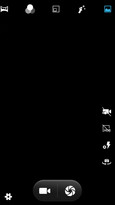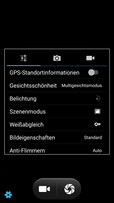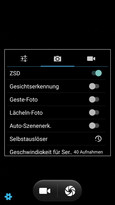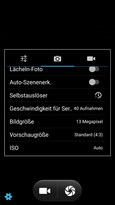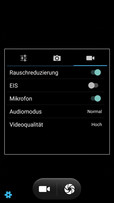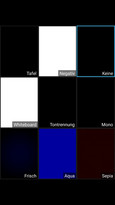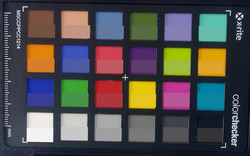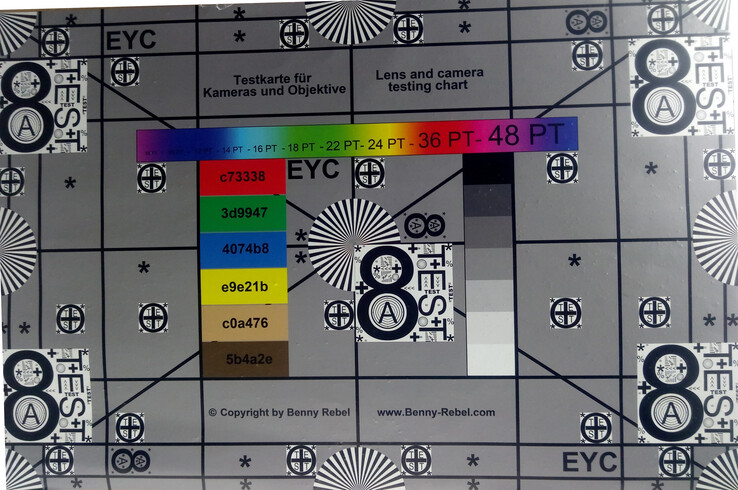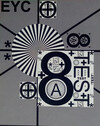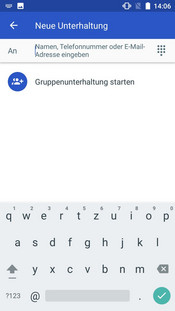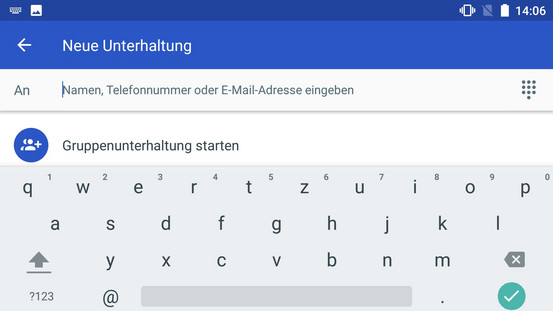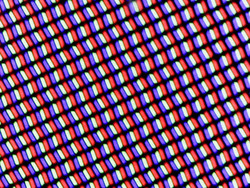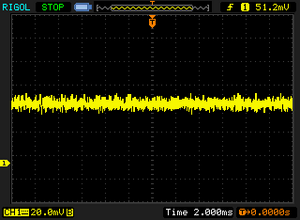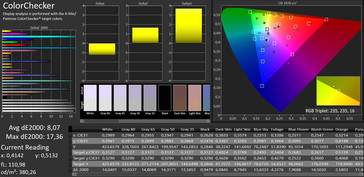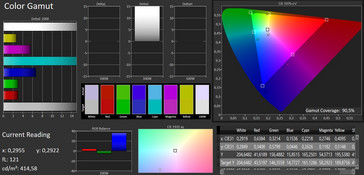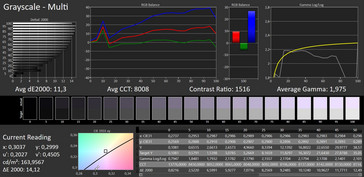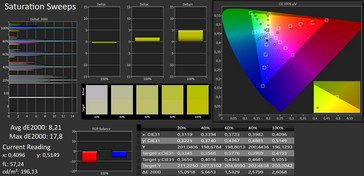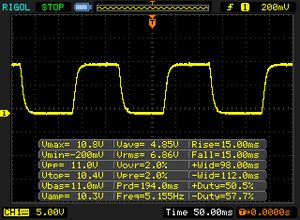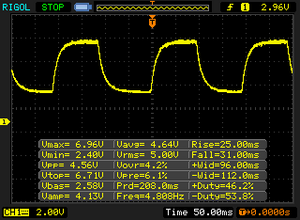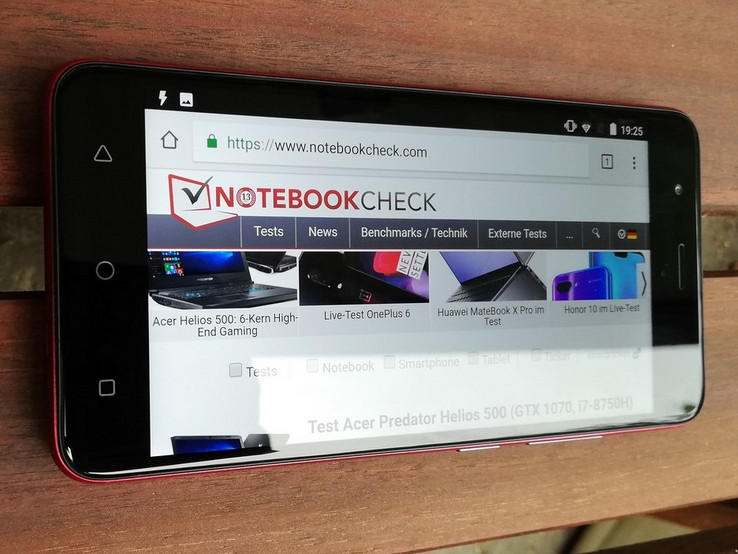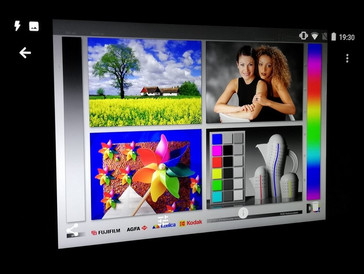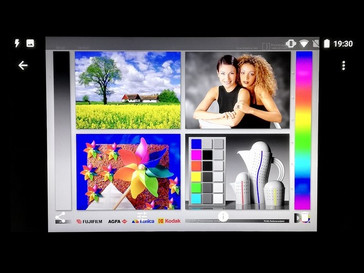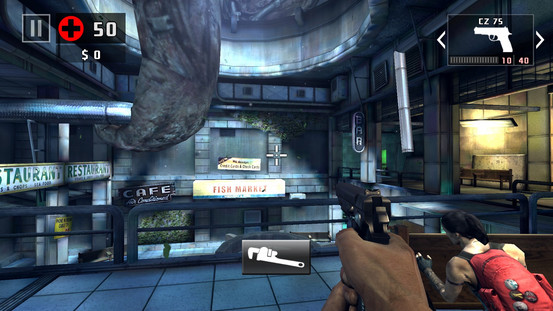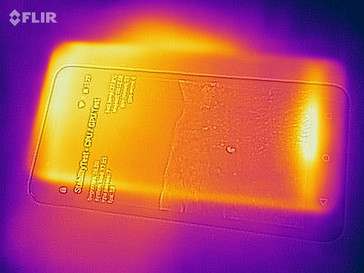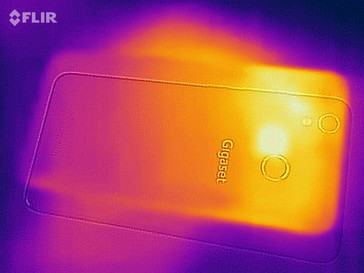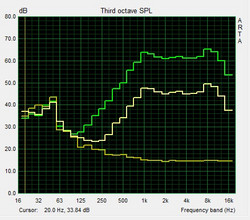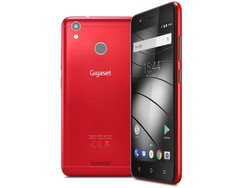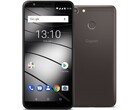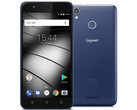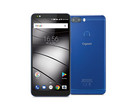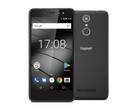Gigaset GS270 Smartphone Review
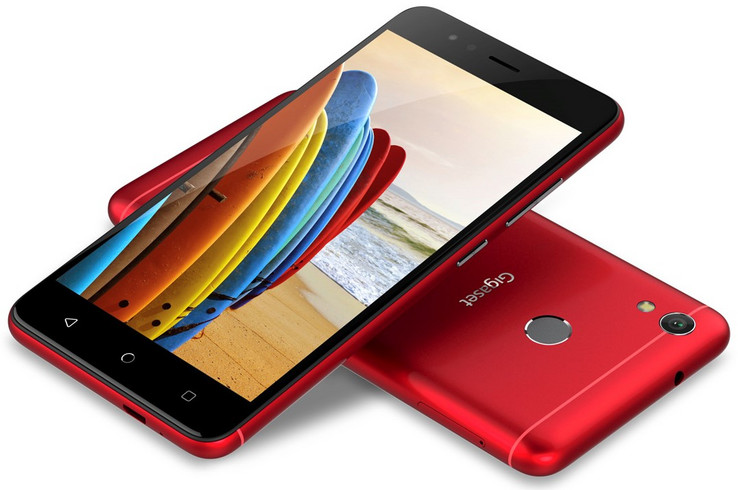
The German manufacturer Gigaset is strengthening its market position with affordable smartphones for various needs. In our tests, the very affordable GS170 was already able to convince us with its solid equipment, and the Gigaset GS370 Plus which can be purchased for 300 Euros (~$351) also shows itself to be competitive despite some performance weaknesses.
Gigaset is positioning the GS270 between those two models, asking for a price of 200 Euros (~$234). For this, interested buyers will get a smartphone of the lower mid-range. The MediaTek MT6750 SoC which is already two years old offers sufficient performance for most Android applications, and the integrated ARM Mali T860-MP2 graphics unit displays particularly older 3D applications smoothly. The package is rounded by 2 GB of working memory and 16 GB of internal eMMC flash storage.
Naturally, there are a few competitors in the price-range of the GS270 that our test unit needs to be compared with. These include the Xiaomi Redmi 5 Plus, the Oukitel's U18, the Huawei Y6 from 2018, and HTC's Desire 12, among others. While this list could have been somewhat longer, we have limited ourselves to these devices to give a good overview.
Case - Gigaset smartphone with good workmanship
Gigaset shows no weaknesses in the case of the GS270. The plastic case is well-built and the operation buttons, camera, and fingerprint sensor are flawlessly set into the frame. The connections for the MicroUSB charging cable and external audio devices with a 3.5 mm connector leave the same impression. The transitions to the display show no uneven gaps. However, the tray for microSD and SIM cards has some slight play in its slot.
Our test unit is kept in the special "Racing Red" color. As an alternative, the Gigaset GS270 is also available in gray.
Equipment - Simple hardware in the GS270
Gigaset is using MediaTek's MT6750 to run the GS270. This SoC was introduced in the second quarter of 2016 and is still used today in affordable smartphones. An integrated ARM Mali T860-MP2 GPU is responsible for the display of graphics contents. While this is also somewhat aged, it is sufficient for most Android applications. In combination with 2 GB of working memory and 16 GB of eMMC flash storage, smooth operation of the Android-7.1 systems is possible.
In addition, the GS270 has a MicroUSB port, allowing you to connect the smartphone to the charger or a PC. You can also connect external audio devices via a 3.5 mm audio port.
Software - Gigaset GS270 with Android Nougat
In terms of the operating system, Gigaset is using Android 7.0 with the security updates at the level of December 5, 2017. The user interface corresponds to pure Android and has not been adapted with its own icons or something similar. In the state of delivery, some apps such as "t-online.de", the "TankenApp," and "wetter.info" are preinstalled. These can be uninstalled without any problems.
If several users are using the Gigaset smartphone, you can add different user accounts in the Settings menu.
Communication and GPS - Inaccurate locating in the Gigaset smartphone
For the connection to the external world, Gigaset GS270 offers various options. From GSM, via 3G, up to LTE, all the important standards are available. With the corresponding reception, the connection to the mobile net does not show any abnormalities. In addition, there is also a/b/g/n-capable WLAN and Bluetooth 4.0.
The WLAN transfer rates that we measured are solid and can be called "good" for a smartphone of this price range. Most of the competitors in our comparison list do significantly worse and only the Oukitel U18 is able to keep up with the values of the Gigaset GS270.
| Networking | |
| iperf3 transmit AX12 | |
| Gigaset GS270 | |
| Oukitel U18 | |
| HTC Desire 12 | |
| Xiaomi Redmi 5 Plus | |
| Huawei Y6 2018 | |
| iperf3 receive AX12 | |
| Oukitel U18 | |
| Gigaset GS270 | |
| HTC Desire 12 | |
| Xiaomi Redmi 5 Plus | |
| Huawei Y6 2018 | |
Using the GPS Test app, we evaluate how accurately the Gigaset GS270 locates its own position. The smartphone is using A-GPS and GLONASS for this. While at an accuracy of 8 meters (~26 ft), its location determination is relatively inaccurate, and the GS270 is able to maintain the satellite connection also indoors.
We compare the GPS of the GS270 with our Garmin Edge 520 reference device on our compulsory bike tour. This shows that the high tolerance level often leads to the curves being cut off. While the covered path is recorded evenly during long straight stretches, the high tolerance of 8 meters (~26 ft) is noticeable here as well. For example, the side of the road where the GS270 travelled cannot be followed clearly.
Telephone Functions and Voice Quality - The GS270 is very quiet
The users of the Gigaset GS270 have the standard Android app available for phone calls, which allows you to have phone conversations with a good voice quality. However, the low overall volume makes communication in loud environments slightly difficult. The hands-free operation also suffers from the same problem. While the conversation partner is also clearly understood here, its low volume requires very quiet surroundings in order to communicate easily.
Cameras - 13 MP for mediocre photos
For photography, the Gigaset GS270 has a 13-MP main camera and a 5-MP front camera. The main camera takes pictures with an f2.2 aperture, auto-focus, and LED flash, while the front camera has a fixed focus and takes rather mediocre pictures in daylight indoors. If you do not get the focus just right, the pictures also become blurry.
The main camera of the Gigaset smartphone only succeeds in taking mediocre pictures as well. We notice a slight over-exposure in particular. The differentiation between light and dark image areas is not good, and image details quickly get lost in blurriness. The effect is getting considerably worse in diminishing light conditions. However, amateur photographers can also use a series of manual setting options and get slightly better results from the camera of the GS270 in that way. The manual camera options include the white balance, exposure settings, and the selection of various scene modes, among other settings.
While video recordings suffer from similar limitations as photos, they are characterized by good image stability. The settings are minimal here and are limited to the activating and deactivating of the image stabilizer, microphone, and various audio modes.
We evaluate the color accuracy of the GS270 camera using the ColorChecker Passport. It shows here that the various color tones are recorded very differently. Most tend to be reproduced too dark, while some red, green, and blue tones should have been brighter.
We also test under controlled light conditions to see how well the GS270 can record details. Our test chart is reproduced slightly too dark. However, you can still see fine lines and structures clearly even at the edges.
Accessories and Warranty - Covers and earphones for the Gigaset
The box of the Gigaset GS270 includes a USB charger, the corresponding MicroUSB cable, and a headset with a 3.5 mm connector. You can also purchase a protective Silicone cover and a booklet case for the GS270 in the Gigaset store.
Gigaset offers a 24-month warranty to the buyers of the GS270. Please see our Guarantees, Return policies and Warranties FAQ for country-specific information.
Input Devices and Operation - Android keyboard and multi-touch
The virtual Android keyboard allows fast and reliable input. Every key press is rewarded with a pleasantly light vibration. The keyboard is comfortable to use in portrait as well as landscape format. The touchscreen offers good sliding characteristics and always works reliably, allowing multi-touch input of up to five fingers simultaneously. Turning the Gigaset to change the orientation of the smartphone works fast and without delay.
Display - Gigaset smartphone with low brightness
The screen of the Gigaset GS270 displays contents at a resolution of 1920x1080 pixels. The 5.2-inch IPS panel is protected by a dirt-repellent and scratch-proof surface. In the comparison, the display is rather mediocre. While some smartphones such as the HTC Desire 12 offer a higher brightness, they also have a lower resolution. At an average brightness of 418 cd/m², the brightness of the GS270 is below average.
| |||||||||||||||||||||||||
Brightness Distribution: 93 %
Center on Battery: 421 cd/m²
Contrast: 1581:1 (Black: 0.27 cd/m²)
ΔE ColorChecker Calman: 6.4 | ∀{0.5-29.43 Ø4.78}
ΔE Greyscale Calman: 8.6 | ∀{0.09-98 Ø5}
89.8% sRGB (Calman 2D)
Gamma: 1.9
CCT: 7366 K
| Gigaset GS270 IPS, 1920x1080, 5.2" | Oukitel U18 LCD IPS, 1512x720, 5.9" | Huawei Y6 2018 IPS, 1440x720, 5.7" | Xiaomi Redmi 5 Plus IPS, 2160x1080, 6" | HTC Desire 12 IPS, 1440x720, 5.5" | |
|---|---|---|---|---|---|
| Screen | -9% | 1% | 12% | 23% | |
| Brightness middle (cd/m²) | 427 | 565 32% | 483 13% | 620 45% | 502 18% |
| Brightness (cd/m²) | 418 | 535 28% | 460 10% | 612 46% | 499 19% |
| Brightness Distribution (%) | 93 | 83 -11% | 88 -5% | 96 3% | 84 -10% |
| Black Level * (cd/m²) | 0.27 | 0.55 -104% | 0.4 -48% | 0.57 -111% | 0.2 26% |
| Contrast (:1) | 1581 | 1027 -35% | 1208 -24% | 1088 -31% | 2510 59% |
| Colorchecker dE 2000 * | 6.4 | 7.1 -11% | 5.8 9% | 3.46 46% | 5.4 16% |
| Colorchecker dE 2000 max. * | 14.24 | 13.7 4% | 12.6 12% | 7.88 45% | 10.8 24% |
| Greyscale dE 2000 * | 8.6 | 6.2 28% | 5 42% | 3.9 55% | 6.2 28% |
| Gamma | 1.9 116% | 2.85 77% | 2.6 85% | 2.073 106% | 2.07 106% |
| CCT | 7366 88% | 7153 91% | 7709 84% | 7230 90% | 7660 85% |
| Colorchecker dE 2000 calibrated * | 4.42 |
* ... smaller is better
Screen Flickering / PWM (Pulse-Width Modulation)
| Screen flickering / PWM not detected | |||
In comparison: 53 % of all tested devices do not use PWM to dim the display. If PWM was detected, an average of 8111 (minimum: 5 - maximum: 343500) Hz was measured. | |||
Gigaset lists a contrast ratio of 1000:1 in the specifications of the GS270. The value that we measured is significantly higher at 1581:1, causing the image contents to appear sharp and vivid. In addition, the low black value ensures a saturated black. In these points, the GS270 surpasses most of our selected competitors, and only the display of the HTC Desire 12 achieves better values.
Display Response Times
| ↔ Response Time Black to White | ||
|---|---|---|
| 30 ms ... rise ↗ and fall ↘ combined | ↗ ms rise | |
| ↘ ms fall | ||
| The screen shows slow response rates in our tests and will be unsatisfactory for gamers. In comparison, all tested devices range from 0.1 (minimum) to 240 (maximum) ms. » 79 % of all devices are better. This means that the measured response time is worse than the average of all tested devices (20.2 ms). | ||
| ↔ Response Time 50% Grey to 80% Grey | ||
| 56 ms ... rise ↗ and fall ↘ combined | ↗ ms rise | |
| ↘ ms fall | ||
| The screen shows slow response rates in our tests and will be unsatisfactory for gamers. In comparison, all tested devices range from 0.165 (minimum) to 636 (maximum) ms. » 92 % of all devices are better. This means that the measured response time is worse than the average of all tested devices (31.6 ms). | ||
The viewing angles of the IPS panel of the GS270 are very stable, and you can see the image contents from any angle without distortions. If there are no interfering reflections from the surroundings, the Gigaset smartphone can also be used in unusual positions.
Performance - Gigaset with MediaTek and ARM
Our test unit is equipped with MediaTek’s MT6750 and an ARM Mali-T860 MP2. This SoC/GPU combination is used in simpler smartphones and offers sufficient performance to ensure the smooth operation of an Android-7.0 system. In combination with 2 GB of working memory and 16 GB of eMMC flash storage, most Android apps and older games can be run. However, you should not expect to run any demanding 3D applications.
Our selected comparison devices are all within a similar price and performance range as the Gigaset GS270. We therefore cannot see a clear winner or loser in the benchmarks either. While the GS270 can surpass the competitors in some tests, it ends up in last place in others. Overall, the offered performance is on the expected level of a 200-Euro device (~$234).
| AnTuTu v6 - Total Score (sort by value) | |
| Gigaset GS270 | |
| Huawei Y6 2018 | |
| Xiaomi Redmi 5 Plus | |
| HTC Desire 12 | |
| Average Mediatek MT6750 (38547 - 44842, n=17) | |
| AnTuTu v7 - Total Score (sort by value) | |
| Gigaset GS270 | |
| Oukitel U18 | |
| Huawei Y6 2018 | |
| Xiaomi Redmi 5 Plus | |
| HTC Desire 12 | |
| Average Mediatek MT6750 (52278 - 56639, n=10) | |
| PCMark for Android | |
| Work performance score (sort by value) | |
| Gigaset GS270 | |
| Oukitel U18 | |
| Huawei Y6 2018 | |
| Xiaomi Redmi 5 Plus | |
| Average Mediatek MT6750 (3667 - 4532, n=13) | |
| Work 2.0 performance score (sort by value) | |
| Gigaset GS270 | |
| Oukitel U18 | |
| Huawei Y6 2018 | |
| Xiaomi Redmi 5 Plus | |
| HTC Desire 12 | |
| Average Mediatek MT6750 (2782 - 3394, n=17) | |
| GFXBench (DX / GLBenchmark) 2.7 | |
| T-Rex Onscreen (sort by value) | |
| Oukitel U18 | |
| Huawei Y6 2018 | |
| Xiaomi Redmi 5 Plus | |
| HTC Desire 12 | |
| Average Mediatek MT6750 (12 - 25, n=16) | |
| Average of class Smartphone (12 - 166, n=156, last 2 years) | |
| 1920x1080 T-Rex Offscreen (sort by value) | |
| Oukitel U18 | |
| Huawei Y6 2018 | |
| Xiaomi Redmi 5 Plus | |
| HTC Desire 12 | |
| Average Mediatek MT6750 (12 - 17, n=16) | |
| Average of class Smartphone (22 - 954, n=156, last 2 years) | |
| GFXBench 3.0 | |
| on screen Manhattan Onscreen OGL (sort by value) | |
| Gigaset GS270 | |
| Oukitel U18 | |
| Huawei Y6 2018 | |
| Xiaomi Redmi 5 Plus | |
| HTC Desire 12 | |
| Average Mediatek MT6750 (5.6 - 13, n=17) | |
| Average of class Smartphone (18 - 166, n=158, last 2 years) | |
| 1920x1080 1080p Manhattan Offscreen (sort by value) | |
| Gigaset GS270 | |
| Oukitel U18 | |
| Huawei Y6 2018 | |
| Xiaomi Redmi 5 Plus | |
| HTC Desire 12 | |
| Average Mediatek MT6750 (5.3 - 7.1, n=17) | |
| Average of class Smartphone (12 - 606, n=157, last 2 years) | |
| GFXBench 3.1 | |
| on screen Manhattan ES 3.1 Onscreen (sort by value) | |
| Gigaset GS270 | |
| Oukitel U18 | |
| Huawei Y6 2018 | |
| Xiaomi Redmi 5 Plus | |
| HTC Desire 12 | |
| Average Mediatek MT6750 (3.8 - 10, n=17) | |
| Average of class Smartphone (11 - 166, n=158, last 2 years) | |
| 1920x1080 Manhattan ES 3.1 Offscreen (sort by value) | |
| Gigaset GS270 | |
| Oukitel U18 | |
| Huawei Y6 2018 | |
| Xiaomi Redmi 5 Plus | |
| HTC Desire 12 | |
| Average Mediatek MT6750 (3.5 - 4.7, n=17) | |
| Average of class Smartphone (8.4 - 413, n=157, last 2 years) | |
There is a clearer result in the browser benchmarks, where the GS270 is exactly in the middle of the field of comparison devices. Subjectively, you can surf fast on the internet, but media contents take a bit longer to be loaded and played.
| JetStream 1.1 - Total Score | |
| Xiaomi Redmi 5 Plus (Chrome 66) | |
| Huawei Y6 2018 (Chrome 66) | |
| Gigaset GS270 | |
| Oukitel U18 (Chrome 65) | |
| Average Mediatek MT6750 (12 - 20.8, n=19) | |
| HTC Desire 12 (Chrome 66.0.3359.158) | |
| Octane V2 - Total Score | |
| Average of class Smartphone (2228 - 121337, n=200, last 2 years) | |
| Xiaomi Redmi 5 Plus (Chrome 66) | |
| Oukitel U18 (Chrome 65) | |
| Gigaset GS270 | |
| Average Mediatek MT6750 (1994 - 3506, n=19) | |
| HTC Desire 12 (Chrome 66.0.3359.158) | |
| Huawei Y6 2018 (Chrome 66) | |
| Mozilla Kraken 1.1 - Total | |
| HTC Desire 12 (Chrome 66.0.3359.158) | |
| Huawei Y6 2018 (Chrome 66) | |
| Oukitel U18 (Chrome 65) | |
| Average Mediatek MT6750 (11708 - 22627, n=19) | |
| Gigaset GS270 | |
| Xiaomi Redmi 5 Plus (Chrome 66) | |
| Average of class Smartphone (257 - 28190, n=155, last 2 years) | |
| WebXPRT 2015 - Overall | |
| Xiaomi Redmi 5 Plus (Chrome 66) | |
| Huawei Y6 2018 (Chrome 66) | |
| Average Mediatek MT6750 (34 - 78, n=5) | |
* ... smaller is better
The internal storage of the Gigaset GS270 is slightly slower than in the other smartphones. Of the total of 16 GB of storage, the user still has about 12 GB available, which can be expanded up to 128 GB via the microSD card slot. You can also store apps on the SD card.
Using our Toshiba Exceria Pro M501 reference storage card, the card reader in the Gigaset smartphone reads and writes at slightly below-average speeds. However, this will not be noticeable in daily operation.
When using a microSD card, you lose the option to use a second SIM card in the GS270.
| Gigaset GS270 | Oukitel U18 | Huawei Y6 2018 | Xiaomi Redmi 5 Plus | HTC Desire 12 | Average 16 GB eMMC Flash | Average of class Smartphone | |
|---|---|---|---|---|---|---|---|
| AndroBench 3-5 | 20% | 9% | 74% | 7% | -27% | 2109% | |
| Sequential Read 256KB (MB/s) | 269 | 273.1 2% | 254.3 -5% | 270 0% | 211.4 -21% | 164.5 ? -39% | 2223 ? 726% |
| Sequential Write 256KB (MB/s) | 44.86 | 109.2 143% | 65.6 46% | 194.5 334% | 103.8 131% | 43 ? -4% | 1838 ? 3997% |
| Random Read 4KB (MB/s) | 34.64 | 28.7 -17% | 38.8 12% | 79.5 130% | 16.69 -52% | 21.7 ? -37% | 295 ? 752% |
| Random Write 4KB (MB/s) | 10.95 | 12.96 18% | 9 -18% | 7.1 -35% | 7.54 -31% | 8.08 ? -26% | 335 ? 2959% |
| Sequential Read 256KB SDCard (MB/s) | 75.8 | 71.5 ? -6% | 84.9 ? 12% | 84.4 11% | 81.8 ? 8% | 59.1 ? -22% | |
| Sequential Write 256KB SDCard (MB/s) | 58.9 | 47.02 ? -20% | 64 ? 9% | 59.5 1% | 61.1 ? 4% | 39.8 ? -32% |
Games - Simple gaming with the GS270
The integrated ARM Mali T860 GPU is suitable for the occasional gamer without high demands. Most of the older games and current casual games can be played without any trouble. We did not see any problems with the slightly older "Dead Trigger 2" and also the simpler "Temple Run 2" in our test. Input from the touchscreen is implemented accurately and the position sensor does not show any weaknesses either.
Emissions - Quiet speaker in the Gigaset phone
Temperature
During everyday usage, the Gigaset GS270 hardly warms. The surface temperatures rise to barely above 32 °C (90 °F) during idle operation. Under load, the 40-degree mark (104 °F) is barely reached. This makes the affordable smartphone a device which creates slightly more excess heat than the other comparable smartphones in our comparison.
(±) The maximum temperature on the upper side is 40.1 °C / 104 F, compared to the average of 35.2 °C / 95 F, ranging from 21.9 to 247 °C for the class Smartphone.
(+) The bottom heats up to a maximum of 38.5 °C / 101 F, compared to the average of 34 °C / 93 F
(+) In idle usage, the average temperature for the upper side is 31 °C / 88 F, compared to the device average of 32.9 °C / 91 F.
Speaker
The speaker of the GS270 is only suited to a limited extent for the reproduction of audio content. Due to its low overall volume, the Gigaset smartphone can only be used in very quiet surroundings. Despite the low volume, voices and other sounds quickly sound tinny. Starting from the mids, the sound spectrum drops strongly towards the lower notes. While other smartphones of this price range also offer an unbalanced sound spectrum, at least they can produce a higher volume.
The included headset is likewise not suited to enjoy music or other sounds. But at least it offers a higher volume during a phone call.
Gigaset GS270 audio analysis
(±) | speaker loudness is average but good (74.4 dB)
Bass 100 - 315 Hz
(-) | nearly no bass - on average 27.2% lower than median
(+) | bass is linear (5.9% delta to prev. frequency)
Mids 400 - 2000 Hz
(±) | reduced mids - on average 5.1% lower than median
(±) | linearity of mids is average (7.5% delta to prev. frequency)
Highs 2 - 16 kHz
(+) | balanced highs - only 2.7% away from median
(+) | highs are linear (2.1% delta to prev. frequency)
Overall 100 - 16.000 Hz
(±) | linearity of overall sound is average (28.4% difference to median)
Compared to same class
» 74% of all tested devices in this class were better, 5% similar, 22% worse
» The best had a delta of 11%, average was 35%, worst was 134%
Compared to all devices tested
» 85% of all tested devices were better, 3% similar, 12% worse
» The best had a delta of 4%, average was 24%, worst was 134%
HTC Desire 12 audio analysis
(+) | speakers can play relatively loud (87 dB)
Bass 100 - 315 Hz
(-) | nearly no bass - on average 35.3% lower than median
(±) | linearity of bass is average (9.4% delta to prev. frequency)
Mids 400 - 2000 Hz
(±) | reduced mids - on average 6.3% lower than median
(±) | linearity of mids is average (10% delta to prev. frequency)
Highs 2 - 16 kHz
(±) | higher highs - on average 6.8% higher than median
(±) | linearity of highs is average (8.7% delta to prev. frequency)
Overall 100 - 16.000 Hz
(±) | linearity of overall sound is average (27.7% difference to median)
Compared to same class
» 72% of all tested devices in this class were better, 5% similar, 24% worse
» The best had a delta of 11%, average was 35%, worst was 134%
Compared to all devices tested
» 84% of all tested devices were better, 3% similar, 13% worse
» The best had a delta of 4%, average was 24%, worst was 134%
Battery Life - Gigaset GS270 with a long battery life
Power Consumption
The Gigaset GS270 is a very energy efficient smartphone. The power consumption is significantly lower than in all the comparison devices. The maximum value we measured is 5.7 watts. The included 10-watt charger should therefore be sufficient to provide power to the GS270 in any circumstance.
| Off / Standby | |
| Idle | |
| Load |
|
Key:
min: | |
| Gigaset GS270 5000 mAh | Oukitel U18 4000 mAh | Huawei Y6 2018 3000 mAh | Xiaomi Redmi 5 Plus 4000 mAh | HTC Desire 12 2730 mAh | Average Mediatek MT6750 | Average of class Smartphone | |
|---|---|---|---|---|---|---|---|
| Power Consumption | -83% | -58% | -35% | -10% | -29% | -33% | |
| Idle Minimum * (Watt) | 0.8 | 1.12 -40% | 1.7 -113% | 0.7 12% | 1.13 -41% | 1.13 ? -41% | 0.848 ? -6% |
| Idle Average * (Watt) | 1.6 | 2.27 -42% | 2.5 -56% | 2.8 -75% | 2.03 -27% | 2.02 ? -26% | 1.435 ? 10% |
| Idle Maximum * (Watt) | 2 | 2.49 -25% | 3.2 -60% | 3.4 -70% | 2.05 -3% | 2.42 ? -21% | 1.62 ? 19% |
| Load Average * (Watt) | 3.7 | 10.75 -191% | 5.2 -41% | 4.2 -14% | 3.68 1% | 5.21 ? -41% | 7 ? -89% |
| Load Maximum * (Watt) | 5.7 | 12.39 -117% | 6.8 -19% | 7.2 -26% | 4.52 21% | 6.56 ? -15% | 11.3 ? -98% |
* ... smaller is better
Battery Life
The biggest strength of the GS270 is its 5000 mAh battery. In our practically relevant WLAN test, the Gigaset smartphone achieved a runtime of more than 12 hours. With this, it surpasses all the other selected competitors and can be placed at the top of our comparison list. Using the included quick charger, the battery is completely recharged in slightly less than 4 hours.
| Gigaset GS270 5000 mAh | Oukitel U18 4000 mAh | Huawei Y6 2018 3000 mAh | Xiaomi Redmi 5 Plus 4000 mAh | HTC Desire 12 2730 mAh | |
|---|---|---|---|---|---|
| Battery runtime | |||||
| WiFi v1.3 (h) | 12.3 | 10.7 -13% | 10.7 -13% | 8.3 -33% | 7.3 -41% |
Pros
Cons
Verdict - Gigaset delivers what was promised
In our test, the Gigaset GS270 presents itself as a smartphone of the lower mid-range that does not have many major weaknesses. The offered performance is on the expected level of the built-in hardware, and apart from the slightly aged Android version, there is hardly any reason for complaint. While many competing devices offer better results in some areas, they have problems in others.
The buyers of the GS270 get exactly what Gigaset has promised: an Android smartphone for 200 Euros (~$234) with a long battery life and a smooth system for everyday usage.
At a price of about 200 Euros (~$234), interested buyers should think about the features of a smartphone that are important to them. Anyone who only takes pictures occasionally and does not need to run demanding programs, will get a solid device with the Gigaset GS270, which is suited for making phone calls and can handle all the usual apps. In addition, it surpasses most of the competitors with its long battery life.
Gigaset GS270
- 05/27/2018 v6 (old)
Mike Wobker




